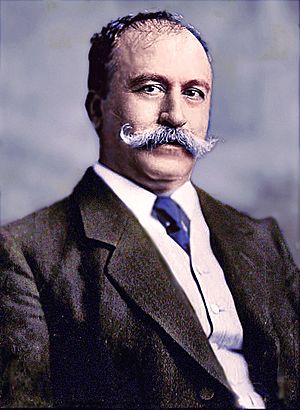Pedro Nel Ospina Vázquez facts for kids
Quick facts for kids
Pedro Nel Ospina
|
|
|---|---|

Photograph of General Pedro Nel Ospina
|
|
| 11th President of Colombia | |
| In office August 7, 1922 – August 7, 1926 |
|
| Preceded by | Jorge Holguín |
| Succeeded by | Miguel Abadía Méndez |
| 7th Governor of Antioquia | |
| In office September 18, 1918 – April 12, 1920 |
|
| Preceded by | Pedro José Berrío |
| Succeeded by | Jesús María Marulanda |
| Personal details | |
| Born |
Pedro Nel Tomás de Villanueva Ospina Vázquez
September 18, 1858 Bogotá, Antioquia State, Granadine Confederation |
| Died | July 1, 1927 (aged 68) Medellín, Antioquia, Colombia |
| Resting place | San Pedro Cemetery Museum |
| Nationality | Colombian |
| Political party | Conservative |
| Spouse | Carolina Vásquez Uribe |
| Relations | Mariano Ospina Rodríguez (father) |
| Children | Pedro Nel Ospina Vásquez, Luis Ospina Vásquez, Manuel Ospina Vásquez, and Elena Ospina Vásquez |
| Alma mater | University of Antioquia UC Berkeley ENSCP |
| Occupation | Engineer, Businessman, Soldier, Professor, Rector and Politician |
| Profession | Engineer (Mining) |
| Military service | |
| Allegiance | Colombian Conservative Party |
| Branch/service | Army |
| Rank | General |
| Battles/wars | War of the Schools, Thousand Days' War |
Pedro Nel Ignacio Tomás de Villanueva Ospina Vásquez (born September 18, 1858 – died July 1, 1927) was an important Colombian general and political leader. He served as the president of Colombia from 1922 to 1926.
Early Life and Education
Pedro Nel Ospina was born in Bogotá, Colombia, on September 18, 1858. He was born in the Presidential Palace because his father, Mariano Ospina Rodríguez, was the president of Colombia at that time.
Pedro Nel Ospina was very well-educated. He studied at the University of Antioquia in Colombia. He also traveled to the United States to study at the University of California, Berkeley. Later, he studied in France at the École nationale supérieure de chimie de Paris. He became an expert in mining engineering.
A Leader in Education
Pedro Nel Ospina played a big role in starting mining engineering education in Colombia. He helped create the Escuela Nacional de Minas (National School of Mines) in Medellín. This school was designed like the School of Mines at the University of California, Berkeley, where Pedro Nel and his brother Tulio Ospina had studied.
When the school reopened in 1904, it offered degrees in many engineering fields. These included chemistry, civil, electrical, mining, and mechanical engineering. As leaders of the school, Pedro Nel and his brother taught students the importance of hard work, discipline, and practical skills.
Engineer and Businessman
Pedro Nel Ospina was not just an engineer; he was also a successful businessman. He saw himself as someone who could create industries and jobs. He was a mining engineer trained at Berkeley and also a large-scale farmer.
Many successful business people and engineers came from the business community in Medellín during this time. Ospina was one of them. Even though he became very successful in politics, he always valued being practical and hardworking.
His Political Journey
Pedro Nel Ospina started his political career as a Member of Parliament. He was elected to the House of Representatives for the province of Antioquia in 1892 and 1894.
Key Actions in Congress
- During his first term, he worked to remove an old law called the “Ley de los Caballos.”
- He also introduced a bill to allow "freedom of speech."
- In his second term, he helped create a bill to reorganize the Banco Nacional (National Bank).
Military Service
Ospina was a General in the Army during the Thousand Days' War, a civil war in Colombia. In 1901, President José Manuel Marroquín appointed him as the Minister of War.
Diplomat and Governor
In 1910, President Carlos Eugenio Restrepo chose Ospina to be the Colombian Ambassador to the United States. After returning to Colombia, he was again elected to congress. Later, he became the Governor of Antioquia in 1918.
In 1920, during President Marco Fidel Suárez's government, Ospina was chosen by congress to be the nation's presidential designate. This meant he was next in line for the presidency.
Becoming President
In 1922, Pedro Nel Ospina was elected as Colombia's 36th president. His time as president was very important for Colombia's development.
Modernizing Colombia
During his presidency (1922-1926), he made many improvements:
- He organized new government departments for Education, Health, and the Treasury.
- He created the Central Bank, known as the Banco de la Republica. This bank helped manage the country's money.
- He greatly improved public works. This included building major national highways and railway systems.
- He also oversaw the construction of dams, bridges, and oil pipelines. These pipelines connected the main oil fields to the sea ports.
Ospina's government helped banking and trade become more organized and grow. In 1928, after his presidency, the Bogotá stock exchange was created, which further helped the economy.
Pedro Nel Ospina passed away in Medellín, Colombia, on July 1, 1927.
Images for kids
See also
 In Spanish: Pedro Nel Ospina para niños
In Spanish: Pedro Nel Ospina para niños


